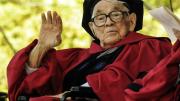Harvard’s Gleason professor of fine arts emeritus and Cabot founding director of the Harvard University Art Museums emeritus Seymour Slive died on June 14, barely two weeks after appearing in Tercentenary Theatre to receive an honorary doctor of arts degree at the University’s 363rd Commencement. As is the custom, President Drew Faust read his citation aloud during the morning exercises:
A living portrait in ebullient erudition and humane inspiration, he has masterfully illumined the works of Dutch masters, his own career a rare work of art.
An authority on seventeenth-century Dutch art, Slive joined the faculty in 1954; he retired in 1991. In 1960, according to The Harvard Crimson, he became the first American professor to lecture in Russia under a Cold War exchange agreement. (He took advantage of his month at the University of Leningrad to study what he called “the greatest single collection of Dutch paintings in the world” at the Hermitage Museum.) From 1975 until 1982 he served as director of Harvard’s Fogg Museum (he was acting director in 1974-75). He was also instrumental in founding the Arthur M. Sackler Museum (to house Harvard’s collections of ancient, Asian, and Islamic art), which will now be consolidated in the unified Harvard Art Museums complex, opening this November. (Read the Crimson’s account of the Sackler’s creation and Slive’s recollections here.)
According to the biographical note in the online Dictionary of Art Historians, “Slive was the first American-trained art historian to specialize in the history of Netherlands Baroque art.” He was renowned in particular for his scholarship on Rembrandt, Frans Hals, and Jacob van Ruisdael, and his lively lectures were appreciated by the undergraduates who took his courses. Sample his style in “Jacob van Ruisdael,” an article from the Harvard Magazine archives.
An obituary will appear in the September-October issue. Read his obituary in The Boston Globe here.
Updated on June 19, at 3:45 p.m., to correct information on Professor Slive’s tenure as museum director.









